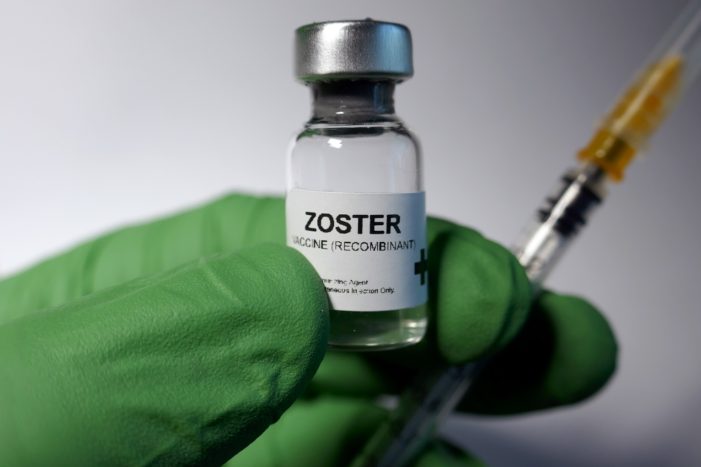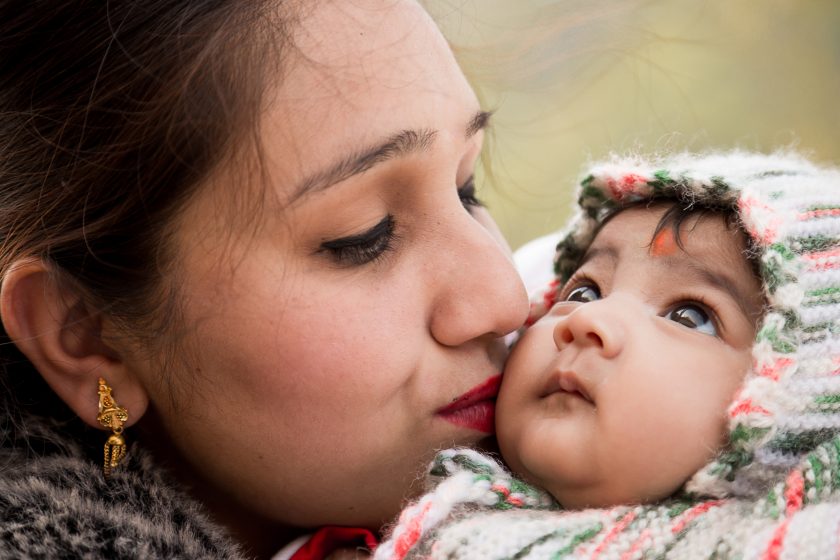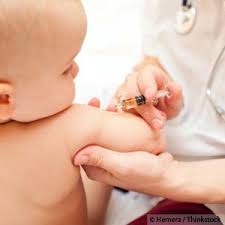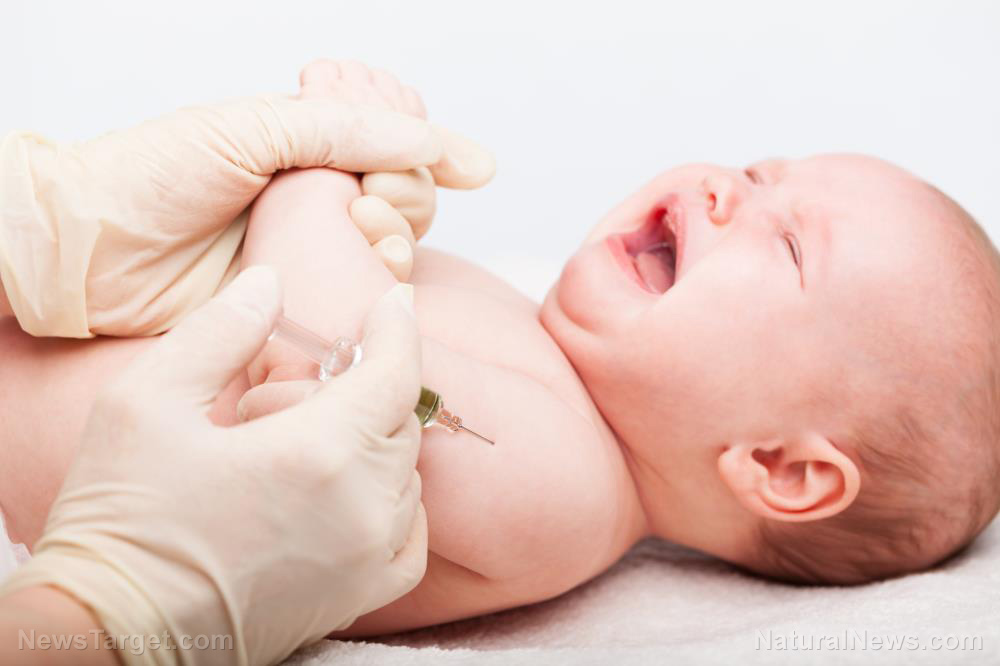1. The Vaccine Reaction: New Supercharged Shingles Vaccine Has Serious Problems
STORY HIGHLIGHTS
- Shingrix, a new high antigen vaccine designed to prevent shingles (herpes zoster), is produced by GlaxoSmithKline and is being aggressively marketed for adults over age 50.
- Approved for use in October 2017, the new vaccine is competing with Merck’s shingles vaccine, Zostavax, and there are already reports that Shingrix is associated with significant administrative errors and both common and severe side effects that may prevent people from returning for the recommended second shot.
- Although not widely known, an increase in the incidence of shingles, particularly among younger people, was predicted and has occurred since the varicella zoster (chickenpox) vaccine was licensed in 1995 and subsequently mandated by states for children to attend school in the U.S.

The new herpes zoster (shingles) vaccine, Shingrix, is produced by GlaxoSmithKline (GSK) and is being marketed as the welcome and best answer to preventing a painful bout with shingles.
GSK’s Shingrix vaccine is in head to head competition with Merck’s shingles vaccine, Zostavax, licensed in 2006.
The relentless advertising for Shingrix is difficult to avoid: It is blared over grocery store speakers, has taken the place of muzak on pharmacy or doctors’ office hold lines, and is aggressively being promoted by nearly the entire medical establishment.
Shingles is caused by reactivation of the chickenpox virus (varicella zoster) in a person who has previously had either natural chickenpox or has received the vaccine.
Children or adults who get shingles suffer with a painful, blistering rash, usually on one side of the body.
The rash and blisters usually last for two or three weeks and the nerve pain may persist for months or even years.1
The condition usually occurs in adults over age 50, which is why public health officials and vaccine manufacturers target that population for marketing shingles vaccines.
However, shingles has also been diagnosed more frequently in children since the chickenpox vaccine was licensed and recommended for all healthy children in 1995.2
Two doses of Shingrix costs close to $300.
Since its approval in October of 2017, Shingrix vaccine has overshadowed the older Zostavax vaccine produced by Merck, which had been the only shingles vaccine available in the U.S. for more than a decade.
Shingrix is reported to be up to 90 percent effective in preventing the development of shingles, compared to an estimated 50 percent effectiveness for Zostavax.3
Administrative Errors
Even among the vaccine’s most ardent supporters, however, the news about Shingrix hasn’t all been positive.
In June, the Centers for Disease Control and Prevention (CDC) published a report discussing a significant number of administrative errors and serious injuries associated with the new shingles vaccine.4
Within the first four months of being on the market, the Vaccine Adverse Event Reporting System (VAERS) received 155 adverse event reports linked to Shingrix.
Several of the errors were attributable to vaccine administrators confusing the two shingles vaccines, which actually differ in significant ways.
Merck’s Zostavax is a live attenuated vaccine (ZVL) that is given once as a single shallow injection, just under the skin (subcutaneous injection).
GlaxoSmithKline’s Shingrix is a recombinant vaccine (RZV) that must be reconstituted prior to injection and is administered deeper into the muscle (intramuscular injection).
Shingrix is given twice, with the second dose given between two and six months after the first one.
The reported errors associated with Shingrix included administration via the subcutaneous route, a mistake that usually caused significant injection site reactions including pain, severe itching (pruritis), and redness (erythema).
Other errors reported were administering the vaccine to patients younger than 50, giving out the wrong vaccine information sheet (VIS), administering just the vaccine’s novel adjuvant without reconstituting it with the actual vaccine antigen, and mistakenly giving the shingles vaccine to a person who was supposed to get chickenpox (varicella zoster) vaccine.
New Adjuvant Turbocharges Immune Response
One of the challenges for manufacturers of inactivated vaccines like Shingrix is that they do not contain a live-virus, which traditionally have provoked stronger immune system responses.
The strong immune system response reported for Shingrix is due to one of the new vaccine’s ingredients, QS-21 Stimulon manufactured by Agenus, Inc.
The novel vaccine adjuvant QS-21 Stimulon is a purified extract from the bark of the Quillaja saponaria vergreen, otherwise known as the soap bark tree.5
QS-21 Stimulon is an “immune potent” adjuvant designed to “turbocharge vaccines by strengthening and broadening immune responses (both T cell and antibody mediated) to a vaccine’s antigens.”
The new adjuvant is currently under study for use in immune therapies against cancer, HIV, and malaria.6
Shingrix vaccine’s novel adjuvant system, AS01B, not only contains QS-21 Stimulon but also MPL (monophosphyoryl lipid a), an immune-stimulating fat. Shingrix ingredients (per dose) include 50 mcg of the QS-21 and 50 mcg of 3-O-desacyl-4’- monophosphoryl lipid A (MPL) from Salmonella minnesota, as well as 50 mcg of its antigen: recombinant glycoprotein E (gE), along with 20 mg of sucrose (as stabilizer), 4.385 mg of sodium chloride, 1 mg of DOPC, 0.54 mg of potassium dihydrogen phosphate, 0.25 mg of cholesterol, 0.160 mg of sodium dihydrogen phosphate dihydrate, 0.15 mg of disodium phosphate anhydrous, 0.116 mg of dipotassium phosphate, and 0.08 mg of polysorbate 80.7
Severe Side Effects
Even when it is administered according to protocol, the Shingrix vaccine is very reactive.
The vaccine’s side effects are known to be more severe than those associated with Zostavax, but public health officials insist the vaccine’s benefits are worth the risk of “skin rash, joint pain, flu-like symptoms, headaches and fatigue” commonly experienced by those who get it.8
Kathleen Dooling, MD of the CDC’s Division of Viral Diseases admitted that more than 70 percent of patients had pain and, “About one in six people experienced side effects so severe that it actually prevented their normal activities.”
In fact, the side effects of Shingrix are so severe that the vaccine’s promoters are concerned that many people will not be willing to go back for the second dose of the vaccine.
Early Warnings of Shingles Epidemic
After participating in a CDC funded study of the effect of widespread use of chickenpox vaccine in California between 1995 and 2002, researcher Gary Goldman, PhD, published a major paper in 2005 warning that the decline in incidence of chickenpox would lead to an increase in children developing shingles.9
In 2003, Goldman predicted that “a large-scale increase in shingles incidence would soon become manifest among adults—a group more susceptible to serious complications.”10
Referring to the “solution” proposed by vaccine manufacturers at the time—to license a booster “shingles” vaccine to substitute for the natural boost in immunity that occurred when people were exposed to wild-type chickenpox in the environment—Goldman said, “This will likely lead to endless disease-and-cure cycles.”
Questions Remain About the Rising Incidence of Shingles
The incidence of shingles is much higher than it used to be, and it is being seen in younger people, though there is disagreement about the reasons for the increase.
Many scientists have suggested that mass vaccination of children with the varicella zoster (chickenpox) vaccine has reduced the presence of the chickenpox virus in the environment, thereby eliminating the natural immune system boost people used to get from exposure to the virus.12
At one point it was thought to provide 20 years of protection, though more current thinking puts the effect at more like two years.12
The current mainstream medical message denies that the chickenpox vaccine is responsible for the observed increase in shingles,13 but others suggest that the knowledge has been deliberately suppressed.14
Article by by Kate Raines
References:
1 Shingles: Overview. American Academy of Dermatology 2018.
2 National Vaccine Information Center. NVIC Challenges VAERS Data of Chickenpox Vaccine Adverse Events. Press Release Sept. 13, 2000.
3 Esposito L. A New Shingles Vaccine: Prepare for Harsher Side Effects. U.S. News & World Report June 15, 2018.
4 Centers for Disease Control and Prevention. Notes from the Field: Vaccine Administration Errors Involving Recombinant Zoster Vaccine — United States, 2017–2018. CDC.gov May 25, 2018.
5 Adjuvants: QS-21 Stimulon®. Agenus. C 2018.
6 Ragupathi G, Gardner JR et al. Natural synthetic saponin adjuvant QS-21 for vaccines against cancer. Expert Rev Vaccines 201; 10(4).
7 Package insert. GlaxoSmithKline Biologicals. C 2017.
8 See Footnote 3.
9 Raines K, Fisher BL. CDC Accused of Manipulating Shingles Data. The Vaccine Reaction Aug. 19, 2018
10 Threat of Shingles Epidemic from Chickenpox Vaccine. Vaccine Choice Canada Oct. 1, 2003.
11 Raines K. Chickenpox Vaccine May Increase Shingles Risk. The Vaccine Reaction Apr. 26, 2016.
12 Chickenpox Vaccination Does Increase Shingles Cases, but Mainly in Young Adults. Science Daily Aug. 11, 2015.
13 Gordon S. Chickenpox Vaccine Not Responsible for Rise in Shingles, Study Says. WebMD Dec. 2, 2013.
14 Goldman GS. The US Universal Varicella Vaccination Program: CDC Censorship of Adverse Public Health Consequences. Annals of Clinical Pathology Mar. 31, 2018.
2. Vactruth: Fertility-Regulating Vaccines Being Tested in India

Furthermore, in part two of the paper, titled Introduction: A U.S. Global Population Strategy, the authors stated:
“From year to year we are learning more about what kind of fertility reduction is feasible in differing LDC situations. Given the laws of compound growth, even comparatively small reductions in fertility over the next decade will make a significant difference in total numbers by the year 2000, and a far more significant one by the year 2050.”
Angered by this paper and how his country had been targeted with vaccinations known to cause infertility, Dr. Ngare stated:
“The reputation of WHO has been called to question many times in the past but there is always inconclusive evidence and a great deal of media sensitization of information that they get away Scot free.
The Catholic Church in Kenya has offered the world irrefutable evidence in this case of the Kenyan tetanus eradication campaign demonstrating clearly the forceful but secretive sterilization of a community. How much more damage and proof will the world demand before action is taken?
This is not an African problem; this is not a racial problem.
It is a problem of good versus evil. Passivity allows evil to thrive and ever flourish.
It is time individuals who stand for what is good understood that the only way to defeat evil is to confront it head on and took action in their area of direct influence e.g. at home, the work place and their local communities.
This chance must not be squandered.
The Catholic Church in Kenya has done its part and will continue to be vigilant.
However, we appeal to the people and private organizations of good will from all across the world to come together and supported the Catholic Church in Kenya to fight the excesses of this organization.”
Having been outed by Dr. Ngare and his team in Africa, these organizations appear to have moved on and there is new evidence to suggest that they are now targeting India.
India Becomes the Latest Target for Population Control
In a recent article titled Ethical questions surround vaccine to reduce fertility, [2] pediatrician Dr. Jacob Puliyel described the clinical trial currently taking place in India.
Dr. Puliyel wrote that the prestigious journal Nature Medicine in its February issue reported that the Indian Council of Medical Research (ICMR) will do a clinical trial of an improved version of a contraceptive vaccine that produces antibodies to the pregnancy hormone, the human chorionic gonadotropin (hCG).
It is to be studied on 120 women in India.
This “vaccine” against pregnancy was developed by Dr. G.P. Talwar.
The idea was to produce antibodies to the pregnancy hormone by conjugating it with another protein, so that the women would not be able to carry a normal pregnancy.
In other words, any woman who is pregnant at the time of vaccination will spontaneously abort their fetus and any women who are not pregnant will be automatically rendered infertile.
“The report is indeed disturbing,” wrote Puliyel.
He continued:
“A few months earlier an article entitled HCG Found in WHO Tetanus Vaccine in Kenya Raises Concern in the Developing World was published by Oller and colleagues in the Open Access Library Journal.”
Reading through Dr. Puliyel’s extremely well-written article, it appears that the fertility controlling vaccination program, originally implemented throughout Kenya in 2014, and subsequently exposed by the Kenyan Catholic Doctors Association, is indeed about to be trialed on the young women of India.
Dr. Puliyel explained that:
“The vaccine programme was promoted by the WHO and the Kenyan government, funded by the Gates Foundation.
Mothers-to-be were encouraged to take the vaccine to prevent tetanus in their unborn babies, without being told that the vaccine would prevent the baby from ever being born.”
He continued:
“…The vaccines used in the campaign were not stored locally, but were distributed directly from Nairobi and the vaccines were guarded by the police.
Every used vaccine vial was returned under police escort to Nairobi at considerable expense.”
In an email, Puliyel told VacTruth that:
“It was clear the WHO had something to hide and were mortified at the thought that they could be exposed if the vaccine was freely available for testing.
It was advised that the vaccine is taken five times at six monthly intervals.
This is unlike the tetanus toxoid schedule anywhere in the world and is exactly the schedule recommended for the “Talwar vaccine.”
WHO publications apparently describe a long-range purpose to reduce population growth in unstable “less developed countries” and they are working on a more potent anti-fertility vaccine, using recombinant DNA.”
In conclusion, he stated that:
“In the context of these reports of the unethical use of the “Talwar vaccine” in Kenya, manufactured by Serum Institute of India, news of the ICMR study is alarming.
It is claimed that the effect of the vaccine is not permanent, but there is no clear evidence that women will be able to conceive at will, after being immunised with this vaccine.”
Reading through the paper published by Nature Medicine, we believe that Dr. Puliyel has every right to be concerned because, according to this publication, Indian biochemist Dr. Gursaran Pran Talwar has been studying vaccinations as a means of birth control since 1972. [3]
According to the author, Killugudi Jayaraman, the lack of availability of suitable birth control in India had prompted Dr. Talwar to investigate alternative methods of birth control that he believed would offer the women better protection.
Jayaraman wrote:
“He (Talwar) believed that a vaccine targeting the hormone called human chorionic gonadotropin (hCG) would be ideal.”
After explaining exactly what the hCG hormone is and how it works, Jayaraman stated that:
“Now after four decades, and having developed three different successively improved versions of an anti-hCG vaccine, Talwar, 91, thinks his idea is finally becoming reality.
In late November, he got the news that he was eagerly waiting for.
The Indian Council of Medical Research (ICMR), the country’s primary funding and coordinating body for biomedical research, informed him it would fund and conduct the clinical trials of his latest vaccine.
A total of 120 women will participate in the testing – 50 in phase 1 trial and 70 in phase 2 trial – at two hospitals in Deli.
According to the letter received by Dr Talwar from the ICMR “the trials are approved to ‘determine the safety and immunogenicity of the vaccine in sexually active healthy women and prove its ability to prevent pregnancy without impairment of ovulation and derangement of menstrual regularity and bleeding profiles.”
Jayaraman explained that whilst the trials had sparked a genuine interest from many of the scientists in India, others were more skeptical and believed that the vaccine was a crazy idea that had the potential to make women permanently infertile.
Jayaraman wrote:
“Will it prevent pregnancy?
Talwar is optimistic but adds that “how long the protection will last will only be clear after the trials.”
He notes that, in clinical trials of the second generation vaccine, many women remained [infertile] for as long as two and half years by taking boosters an average of every three months to maintain the desired antibody levels.
Talwar does not believe there is a risk of long-term infertility from the vaccine and says a women can conceive a child by skipping the boosters and waiting until her antibody levels drop below a certain level.”
In other words, Talwar hasn’t a clue whether or not:
a) the vaccination will work
b) if it does, how long the protection will last
c) whether the vaccine can cause infertility
One scientist, Sarojini Nadimpally, a feminist bioethicist and the founder of Sama, a Delhi-based resource group for women and health, stated that, in her opinion, “Vaccines were made against infections not contraception.”
She may well have a point, especially as she is not the only professional in India to believe that these vaccinations are a step too far.
We asked Dr. Puliyel about the fertility-regulating vaccines that are currently being trialed in India. He told us:
“Where is there a need for this vaccine when there are so many other methods of temporary and permanent contraception available.
Why should the ICMR be testing an improved version of a vaccine clandestinely used in Africa?”
Dr. Puliyel sent us the denial of UNICEF and WHO after the Kenya story became public and stated that:
“Even here in the denial the WHO is being disingenuous.
The WHO’s statement asserts that hCG is a hormone naturally produced in humans and very large amounts are needed to be a threat to pregnancy.
It is implied that the small amounts found in the vaccine cannot cause abortions. “Their statement misrepresents the mechanism of how the Talwar contraceptive vaccine works by conjugating a tiny amount of hCG with another foreign protein, such that antibodies are produced both against the foreign protein and also against hCG.
The fact that the ICMR is going to test this contraceptive vaccine is proof that their concept has been accepted scientifically.” [5]
Puliyel concluded that, in his opinion, WHO and UNICEF are attempting to mislead the public with this misrepresentation.
We believe that he could be correct, especially as there is strong evidence to suggest that vaccinations containing the hCG hormone are known by WHO to render primates infertile.
Are Fertility-Regulating Vaccines that Render Primates Infertile a Step Too Far?
In 1992, WHO, the United Nations Development Program (UNDP), the United Nations Population Fund (UNFPA) and the World Bank met in Geneva, Switzerland, to discuss the then-current status for the development of fertility-regulating vaccinations.
Their meeting was described in detail in an aptly titled paper titled Fertility Regulating Vaccines. [4]
At first glance, the paper appeared to be discussing various methods of family planning with women’s health advocates and scientists from developing countries.
On further reading however, something far more worrying emerged.
During the introduction, WHO discussed “fertility regulation” and how their specialist program would carry out activities to strengthen the research capabilities of developing countries, enabling them to meet their own research needs and participate in the global effort in human reproduction research.
The Meeting Takes a Sinister Turn
There were twenty participants at the meeting, ten scientists and clinicians from Australia, Europe, India and the USA involved in funding fertility regulatory vaccines (FRVs) research, and ten women’s health advocates from Africa, North and South America, Asia and Europe, with backgrounds in immunology, service delivery and social and clinical research, as well as a wide experience of working with women.
The purpose of the meeting was to discuss a new approach to “fertility regulation.”
On page 12 of the report, the groups can be found discussing the development of vaccinations against hCG, a hormone produced by the cells surrounding the early embryo and later by the placenta during pregnancy.
Primates are Rendered Infertile
WHO stated that hCG is a hormone produced by the body to establish and maintain a pregnancy and further stated that when primates were vaccinated using anti-hCG vaccines, they were rendered infertile without any detectable alteration to their menstrual cycle! Just as is claimed by Dr. Talwar for his vaccine.
Throughout their paper, there appeared to be little indication as to whether the infertility of the primates was permanent or temporary, which we found to be extremely worrying.
According to WHO, anti-hGC vaccinations were being developed independently by the National Institute of Immunology (NII) in New Delhi, the Population Council in New York and Development and Research Training in Human Reproduction (HRP).
The report stated that most of the work was still in the experimental stages; however, even then, vaccines using hormones had reached the clinical testing stages.
The Plot Deepens
On page 15, the report stated that it had been “noted that the research on all three anti hCG vaccines was still at an early stage and that a further 5-10 years of testing, evaluation and further development would probably be needed before any of these vaccines would be suitable for marketing.”
However, on page 17, alarm bells began to ring as the authors revealed that the main carriers being used in the prototype vaccines were the diphtheria toxoid DT and the tetanus toxoid TT, which are the very vaccinations that are being implemented throughout developing countries today.
These documents and our research proves that this was a well-thought out plan that originated as far back at the 1970s.
As you can see, these agencies have been systematically plotting to lower the population for many years and it appears that, at last, all their hard work is beginning to pay off.
So far, according to Kenya’s opposition leader Raila Odinga, at least 500,000 young girls and women may now have become infertile, following the tetanus vaccine that was administered by the Kenyan government in 2014 and 2015. [5, 6]
References
- http://www.population-security.org/28-APP2.html
- https://www.sundayguardianlive.com…
- http://rdcu.be/Gug
- https://www.unicef.org/kenya/media_15665.html
- http://apps.who…
- https://thefreethoughtproject.com/pharma-co-vaccine-license-sterilization/

